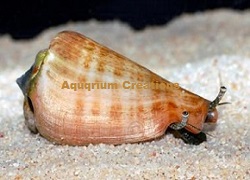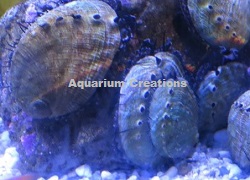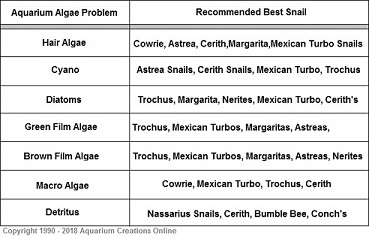Tiger Sand Conch

Totally peaceful toward other tank mates.
Great for Cleaning Sand, even Red Slime algae)
Description:
The Tiger Sand Conch from Papau New Guinea is a hardy member of the Strombidae family. Also called the fighting conch, despite their name they are peaceful as they come toward other tank mates. They are excellent sand sifters, and are very beneficial in the reef aquarium. As they burrow and dig through the aquarium substrate, they clean and aerate the bottom. Terrific for Cleaning Tanks with that ugly red
or brown slime algae often seen. A hardy algae eaters , one of the few that will rid a tank of slime algae, they also love the brown diatoms found on the surface of live sand beds. They will stir
and clean upper layers of the sand bed. As they burrow and dig through the aquarium substrate they clean and aerate the bottom. Tiger Sand Conch will do an excellent job of cleaning the live sand
in your reef tank, where you don't have to sift it around ever! Tigger Sand Conchs sleep at night, and clean with the lights on. Watch the cleaning with what looks like an anteater snout is very
entertaining as they move it everywhere to feed. Conchs always stay on the bottom of the aquarium and never bother other invertebrates or coral.
Tank Recommendations:
Conchs are moderately easy to keep as long as they have a live sand bed to live in. Refrain from using copper based medications and keep an eye on the levels of soluble waste since all saltwater snails are sensitive to nitrates.
Can they Right Themselves if they Get Upside-down?: Yes
Food and diet:
Tiger Sand Conchs are an excellent scavenger. They will eat meaty bits of Brine Shrimp, Mysis Shrimp, fish and Scallop and Scavenge on decaying organic matter, detritus, and fish waste. If there is not ample food supply in your marine aquarium, you may supplement their diet with the meaty bits of fish and sea food.
Recommended Quantity:
1 per 20 gallons
Level of Care: Moderately Easy
Reef Compatibility
:Excellent
Approximate Purchase Size:
2"
|
Price Each $12.99
Pack of 2 $21.99
|
Orange Spot Butterscotch Nassarius Snail
Babylonia formosae
Description:
These are one of the most beautiful of all the saltwater snails. A member of the Nassarius falmily, the Orange Spotted Butterscotch Nassarius Snail will bury themselves
in the sand with only their siphon out. They have quite well developed olfactory sense. As soon as they can smell food, they will rush towards it in groups. An aquarium with a thick layer of sand is
recommended. Owing to their scavenging nature, the Orange Spotted Butterscotch Nassarius Snail will eat perishable organic matter, detritus, any uneaten food in your marine aquarium thereby preventing your
tank water from being contaminated. The Orange Spotted Butterscotch species will sift through the sand in the search of food, thereby aerating the substrate. The ploughing of sand in your marine aquarium
also helps curb the growth of Red Slime Algae, called Cyanobacteria, on the sand.
Tank Recomendations:
The Orange Spot Butterscotch Nassarius Snails are moderately easy to keep as long as they have a live sand bed to live in. Refrain from using copper based
medications and keep an eye on the levels of soluble waste since all saltwater snails are sensitive to nitrates.
Can they Right Themselves if they Get Upside-down?: Yes
Food and diet:
Orange Spotted Butterscotch Nassarius Snail is carnivorous and of course are scavengers in feeding habit. They will eat meaty bits of Brine Shrimp, Mysis Shrimp, fish and Scallop
and Scavenge on detritus and fish waste. If there is not ample food supply in your marine aquarium, you may supplement their diet with the meaty bits of fish and sea food.
Recommended Quantity:1 per 10 gallons
Level of Care: Moderately Easy
Reef Compatibility:Excellent
Approximate Purchase Size: 1"
|
Price Each OUT OF STOCK
Pack of 2 OUT OF STOCK
|
Large Super Tongan Nassarius Snail
Nassarius distortus
Description:
A larger species of Nassarius Snail than the nassarius vibex, the Super Tongan Nassarius Snail (Nassarius distortus) is also referred to as the Tongan Nassarius Snail or Pacific Nassarius Snail. The Super Nassarius like its mini cousin (nassarius vibex), is non-aggressive towards all marine aquarium members. It joyfully feeds on decaying organic material, detritus, uneaten food, and waste in the aquarium. When relaxing, Tonga Nassarius Snails bury themselves in the sand bed with only their siphon out. The Nassarius species have quite well developed olfactory sense. On the first scent of food it will surface from the sand and move quite quickly toward its bounty. Roughly 1" in size which is about twice the size of the Nassarius vibex the Tonga Nassarius snails will clean your aquarium substrate, climb your rockwork scavenging left over fish food, decaying matter and other meaty bits and do a great job mixing up and airating the sandbed. Extremely hardy they are fascinating and entertaining little creatures you will get lots of enjoyment out of these critters.
Tank Recomendations:
The Super Tongan Nassarius Snail is best for larger aquariums 50 gallons and up. Make sure your tank has a live sand bed. Refrain from using copper based medications and keep an eye on the levels of soluble waste since all saltwater snails are sensitive to nitrates.
Can they Right Themselves if they Get Upside-down?: Yes
Food and diet:
Super Tongan Nassarius Snails can typically find enough food in most saltwater reef aquariums with a well established sandbed. If you feel there may not be enough food simply supplement their diet with frozen meaty foods, such as brine shrimp, mysis shrimp, or pieces of fish or scallops.
Recommended Quantity:1 per 5 gallons
Level of Care: Moderately Easy
Reef Compatibility:Excellent
Approximate Purchase Size: 3/4"" |
Price Each $2.99
Pack of 10 $28.99
Pack of 20 $55.99
|
Tropical Abalone

|
Description:
The Abalone is useful in reef aquariums because it eat tons of algae. An abalone has a single shell that covers its body and has many holes called apertures.
The holes help circulate water over their gills. Abalone attach themselves strongly to rocks, using a muscular foot. They feed by trapping algae under their foot and scraping it off with their
radula. It is generally nocturnal, finding refuge in holes or crevices in the rocks or coral during the day, and coming out to forage at night, using its foot to glide over the substrate
and coral rubble. The foot attaches very firmly, so use extreme caution if attempting to remove it from glass or rocks.
Tank Recommendations:
The Abalone has a calcium-based shell which protects it from most predators, but requires the maintenance of proper calcium levels in the water for proper growth. Nitrates should be kept at low levels and it should never
be exposed to copper based medications.
Can they Right Themselves if they Get Upside-down?: No
Food and diet:
While its diet is almost exclusively algae, it would benefit from supplementation with dried seaweed, blanched lettuce, spinach, or Spirulina sheets/tablets.
Recommended Quantity:1 per 15 gallons
Level of Care: Moderate
Reef Compatibility:Excellent
Approximate Purchase Size: 1-1/2" to 2"
|
|
Bumble Bee Snails
Description:
The Bumble bee snail is excellent for getting into the small crevices and tight locations such as in the rock work where other cleaners are just to large to fit. A carnivore, they eat just about everything (but normally won't touch corals), and are an excellent cleanup member for taking care of impossible to get to detritus, including uneaten meaty foods and decomposing organisms. Bumblebee Snails are more carnivorous than many other species and are known to feed on other snails, ornamental feather dusters or the occasional coral polyp if their supply of leftover foods, tiny crustaceans or small worms in the substrate grows too low. The risk is low though compared to the benefits though to anyone with a bristleworm problem or flatworm population. If you are finding many bristleworms or flatworm in your aquarium a handful of Bumblebee Snails will keep the problem under control. Being able to feed on their own food they will leave their tank mates alone. If you find the population of your worm population has gotten very low add tiny meaty foods on the rock work for the Bumble Bees and they will continue to be excellent tank mates. While Bumblebee Snails aren’t quite as proficient sand-sifters as the ever-popular Nassarius Snails, they do sort through the substrate and aquarium rockwork to find their food – the same places that the dreaded worms hide. Quite hardy a stunning snail with a striped black and yellow pattern that resembles the pattern of a bumble bee – hence the name. They originate from the Indo-Pacific region, but can also be found in the waters of Florida. Many of the snails in the trade are collected off the Marshall Islands, a Micronesian nation of islands in the middle of the Pacific Ocean.
Tank Recommendations:
Reef tank must have live sand. The Bumble Bee snail is moderately easy to keep as long as you refrain from using copper based medications and keep an eye on the levels of soluble waste since all saltwater snails are sensitive to nitrates.
Can they Right Themselves if they Get Upside-down?: Yes
Food and diet:
Bumble Bee Snails will take care of flat worms and Bristle worms in your tank. They also eat meaty foods such as bits of Brine Shrimp, Mysis Shrimp, fish and Scallop and Scavenge on detritus and fish waste. If there is not ample food supply in your marine aquarium, you may supplement their diet with the meaty bits of fish and sea food along with algae pellets or algae wafers.
Recommended Quantity:1 per 5 gallons
Level of Care: Moderate
Reef Compatibility:With Caution , need to be fed and they won't touch corals
Approximate Purchase Size:1/4" to 1/2"
|
Price Each $ 2.99 each
Pack of of 6 $17.94 (2.99 ea.)
Pack of 12 $ 28.79 (2.39 ea.)
Pack of 25 $ 59.25 (2.37 ea.)
Pack of 50 $117.50 (2.35 ea.)
Pack of 100 $233.00 (2.33 ea.)
|
Banded Trochus Snails
Description:
The Trochus snail is also called the top shell snails or turban snails, and are distributed across the Indo-Pacific region from the Indian Ocean to Northern Australia.. They move very slowly but leave
nothing behind, eating filamentous algae, slime algae, green algae, diatoms, and cyanbacteria. Add to this the fact that they are able to right themselves if they fall on their backs. Pyramid shaped similar to an Astrea snail,
they get about the size of a quarter when full grown. Trochus are particularly adept at grazing on algae that appear in the earlier stages of a system’s cycling and maturation period, namely films produced by diatoms and/or green algae that may blanket the rock work and tank panels. They additionally will (unlike many other snails) consume cyano bacterial sheets. They tend to stay above the sand line when grazing on the aquarium glass; for this reason, they may be very effectively complimented by the presence of cerith snails, which tend to eat film algae on the glass up to the sand line. One to five individual trochus snails are recommended per gallon of system volume, depending upon factors such as degree of algal fouling and desired speed of clean-up. Once these hungry snails have completely decimated the algal films, their diet should be occasionally supplemented with an algae wafer or two dropped in during evening hours. Another great thing about trochus snails is that they are relatively hardy and long-lived. Because it is atropical animal, if acclimated well it is likely to live out its full lifespan in your reef tank. Because of their peaceful manner trochus snails are successfully used by aquarists of all levels of experience. Their low cost and high reliability makes them a great candidate for any clean-up crew. Though they once in a while may knock down a loosely secured objects such as new coral frag, they are far less destructive than similar snails such as turbo snails. Overall, their many good attributes greatly outweigh any minor problem.
Tank Recommendations:
Trochus Snails are moderately easy to keep as long as you refrain from using copper based medications and keep an eye on the levels of soluble waste since all saltwater snails are sensitive to nitrates.
Can they Right Themselves if they Get Upside-down?: Yes
Food and diet:If food levels are insufficient in your aquarium, supplement their diet with dried seaweed and algae based pellet food or wafers.
Recommended Quantity:1 per 6 gallons
Level of Care: Moderately Easy
Reef Compatibility:Excellent
Approximate Purchase Size: 3/4"
|
Price Each $2.99 each
Pack of of 6 $17.94 (2.99 ea.)
Pack of of 12 $35.88 (2.99 ea.)
Pack of of 25 $72.25 (2.89 ea.)
Pack of of 50 $139.50 (2.79 ea.)
Pack of of 100 $269.00 (2.69 ea.)
|



